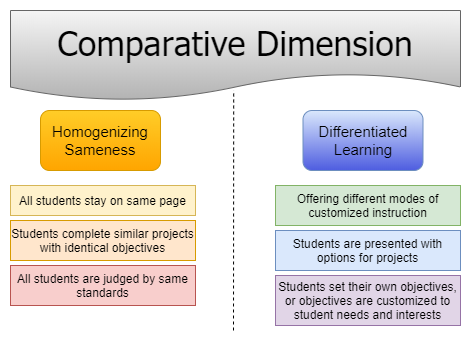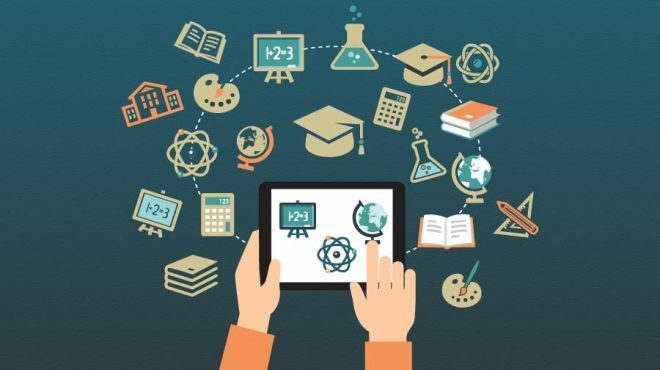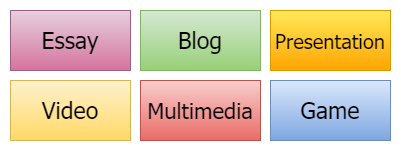Mj Johns’s Updates
Differentiated Learning: Adaptive Learning and Adaptive Technology
Differentiated learning, as presented in this module, is a philosophy and a framework to custom tailor the learning experience to each students’ needs. Traditionally, though this would have been desired, it was extremely difficult to achieve. Teachers needing to manage many students confined in the classroom with limited resources would have been hard-pressed to tailor their instruction to each student.
The advent of e-Learning and technology-mediate instruction offers new hope that this level of customization is now not only a possibility, it may even be quite feasible and reasonable to accomplish. The sub-topic I've chosen to focus on, which I think has the biggest potential to impact the process, is adaptive learning (or adaptive teaching).
According to wikipedia: “adaptive learning, also known as adaptive teaching, is an educational method which uses computer algorithms to orchestrate the interaction with the learner and deliver customized resources and learning activities to address the unique needs of each learner.” [1]
One example of this approach is in adaptive testing, used in some standardized tests like the GRE. When a student takes the GRE, their score on earlier sections determines the difficulty of later sections - so if they do really well the test gets harder, but if they do poorly the test gets easier. This is accomplished using computer algorithms and results in the test being able to more accurately understand and predict a student’s skill level.
Some might hear the words “computer algorithms” and immediately shrug this off as too complex to understand. It doesn’t help much that most of the “explanatory” imagery presented for the topic look like complicated diagrams - possibly useful, but initially difficult to comprehend.
Let’s take a simpler, more approachable example of adaptive technology in general. Most of us are familiar with Netflix - a streaming service for TV and movies. You probably are already aware that Netflix customizes your experience with the service based on what you like - when you first hit the landing page, it shows you things you’ve recently watched and where you left off, it suggests new shows and movies based on your interests, and it gives you alerts when a new episode comes out for one of your favorite shows. How does Netflix do all of this? It uses “computer algorithms” to make assessments of you and your interests based on your activity, which Netflix tracks. You click on a new show, now Netflix has some information about what you might like. You finish the whole first season in one sitting, now Netflix knows you really like it. Netflix uses a database of information to find other similar shows to recommend for you. [3]
This is where we start getting into big data - Netflix is collecting info on its millions of users and using that info to determine patterns in watching habits, which they can then use to base their recommendations. This elaborate process is lucrative for Netflix because creating a custom experience for each viewer helps to ensure that viewers will always find something new that interests them, so they won’t cancel their subscription.
Now that we have a tangible and approachable example of using adaptive technology to create custom experiences, we can look at how that can be applied to learning.
Much like the Netflix viewer, each student comes with their own interests, background, and prior experience. By collecting data on student interactions with a particular subject or piece of learning content, the computer algorithm can analyze their proficiency, offering them more challenges or a simpler example as needed, and focusing on areas that seem to hold a student’s interest.
I believe this adaptive technology could also be used effectively in collaborative efforts. In the example from the module, one student is doing a project on insects because they like insects, and another student is doing their project on pelicans. When they review each other’s projects it gives them insight into what is exciting about the other topic, which they may not have considered before. I think this is particularly compelling because a student doing a project on something they love is more likely to show it in a light that resonates with other students, as opposed to a teacher giving a lecture on that topic.
So the challenge here is to engage the learners with each other while using the differentiated approach offered by the adaptive technology.
My idea is to support learners with different skills and interests by allowing different modes of presentation of their learning. This is inspired by the principles of Universal Design for Learning, which suggests that students have different ways of expressing themselves and their understanding that should be supported by the design of assignments. [5] https://udl.berkeley.edu/
Technology can support this differentiated approach, giving many means of completing the assignment and sharing with others. At the start of the project, students might be given a variety of options for how to present their topic.
This could be writing a traditional essay, creating a blog series, giving a live presentation in front of the class, creating a video recording of their experiment and the results, building a multimedia project, or designing a game that conveys the meaning of their topic.
The next step would be using adaptive technology to assist with forming “review groups” of students based on shared interest in their mode of presentation. This would allow students more interested in reading and writing to share written content, and students more interested in visual or interactive content to engage with those modes, respectively.
I believe that this approach to Differentiated Learning built on Adaptive Technology could have a lot of promise in the classroom.
References:
[1] Wikipedia on Adaptive Learning https://en.wikipedia.org/wiki/Adaptive_learning
[2] Intelligent Adaptive Learning: An Essential Element of 21st Century Teaching and Learning, Cheryl Lemke, Metiri Group, 2013
[3] Netflix on Adaptive Technology https://help.netflix.com/en/node/100639
[4] Why Developers of Adaptive-Learning Technologies Are Missing the Mark https://marketbrief.edweek.org/analysts-view/why-developers-of-adaptive-learning-technologies-are-missing-the-mark/
[5] UDL-Universe https://udl.berkeley.edu/
[6] Adaptive Learning, Andrew D. Carson, The SAGE Encyclopedia of Online Education http://dx.doi.org.ezproxy.lib.utexas.edu/10.4135/9781483318332.n21





